2014 新年群展 Benoît & Bo 东波&西波 专访 | Interview with Benoît & Bo
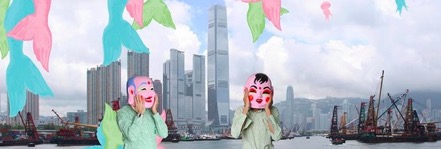
东波西波艺术组合诞生于2002年在天津。
他们于2004年定居巴黎并开始在法中两国展览他们的艺术作品。他们作品被很多法国私人收藏家收藏。2007年他们回到中国并开始了在上海的生活创作。
东波西波既是艺术家,同时也是独立策展人以及北大当代艺术年鉴的艺术评论。
我们有幸在本次12月14日开幕的节日群展中采访到这对来自中法两国的艺术家组合东波西波。
The Benoit+Bo duo was created in 2002 in Tianjin. They settled in Paris in 2004 and today their works are exhibited both in France and China. Moreover, a number of their works have been collected by French collectors and museums. In 2007, they returned to China and started their new life in Shanghai. Benoit+Bo are independent curators who are also art critics of the Bejing University Yearbook of contemporary Art.
We have had the opportunity of interviewing French and Chinese Duo during the Noeli Gallery Holiday Group Exhibition on December 14th.
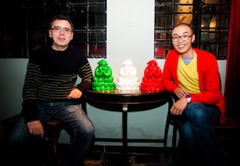
1. 你们大部分作品的灵感来源于哪儿?
灵感来源于各处。可以来自日常生活,童年经历,艺术杰作,民间艺术或是当代的一些问题。
灵感来源的多样性使我们拥有众多可以用来表达我们艺术关注点的方式或媒介。例如,现代城市,当今的传播和交通方式,国界线的消失(地理的或是文化上的),当代人对空间或是时间关系的看法以及民间的大头娃娃给我们不同的灵感,我们做了一系列当代数码图片/照片。我们的《航行日记》数码图片系列的灵感主要来源于针灸图,第一批欧洲冒险家绘制的地图。《标语》系列的灵感来源于日常生活,周遭可见的标语和街上拍结婚照的情侣。
1.Where did your inspirations come from for most of your artwork?
“From everywhere: it could be from daily life, from our childhood, from masterpieces, from folk art or from the concerns of the contemporary times.
The great variety of the inspirations’ origins gives us different possibilities of medium for expressing our artistic concerns. For example, the urban cites, the modern way of communications and the desperation of the borderline (physique or cultural),the contemporary perception of time and space, Chinese folk art (big Chinese heads) inspired us for our series of big photos, the ancient acupuncture and the maps did by the first European travelers inspired us the series of “Journal of Voyage” with the medium of digital picture, the slogans and the Chinese wedding photos inspired us the series of slogan photos…”
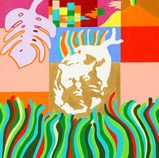
2. 喜欢你们作品的有西方人也有亚洲人,怎样做到相对中国人以外让外国人也能感知你的作品?
面对我们的作品,外国观者和中国观者反应是不同的。
中国的观者的文化参照和外国观者不同。可能外国观者总体上会从画面上的一些因素,自发地去诠释,诠释的内容和空间可能更大。但是我们做画用很多饱和的颜色,中国观者对饱和的颜色会有很快,很积极的反应。但是两者都会说我们的作品流露出强烈的对方文化的色彩。
2.You target both the Western and Asian community. How do Expats and “ 外国人” perceive your artworks compared to the Chinese?
“Chinese people don’t have the same references. I think that expats are more spontaneous and have seen more things. However, Chinese in general use more saturated colors hence with the Chinese public we usually have a more reactive reaction. It’s funny because in many of our paintings, Chinese people say that our paintings are European and European people say it’s more Chinese.”
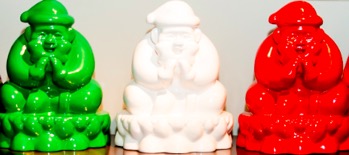
3. 为什么叫作品“圣诞老佛爷”代表了什么?中国人是如何看待这类作品的?
他代表一种含有幽默的幸福。我们觉得中国人认为他很可爱。他们反应地很积极,他们很喜欢他。
事实上, 我们的圣诞老佛爷雕塑很能够代表这种东西方观者对我们作品的文化诠释,中国人会觉得他很圣诞,西方人会觉得他佛陀。
3.Why the Christmas Buddha. What does it represent? How do the Chinese perceive this?
It represents Happiness with a kind of humor. We think that they find this creature cute. Their reaction shows that generally they love it.
In fact, this is highly representative with our Christmas Buddha painting where Westerners say the sculpture is a Buddha while Chinese say it’s a Santa Clause.
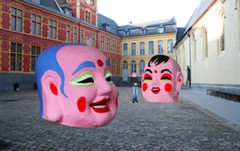
4. 你们的目标是通过作品来让观者感知些什么吗?
可能由于我们的文化背景不同,作品肯定会流露出一些文化背景的因素在其中。就像我们的灵感的来源一样,来源是很多元的,所以表达以及使用的艺术语言也是很多元的。但是这不是我们的创作目的。创作目的其实很根本:创作一副图画。
Is your goal to give a hybrid perception through your artworks?
Yes indeed, I’m French and Bo is Chinese and we make the paintings together, hence we end up creating a type of hybrid mixture crossing cultures. The regard that we expose to China and Europe has mixed meanings where cultures also end up crossing as well. However we don’t necessarily want to impose a meaning to our public with our creations as they are free to let their own creativity flow.
5. 请说一说你们在作品中经常用到的一些技法和材质?
你知道我们使用多种媒介,对于不同的媒介我们会使用不同的创作技术。但是我们认为技术不是重要的,重要的是最终的目的:创作一副图画。
Explain some of the art techniques you generally use?
As you know we are working with different mediums, every medium demands a different technique. But the technique is not important; the importance is the final result: the creation of a picture.
6. 能否提前跟我们谈下你们将来的一个创作方向?
我们最近在准备一个庞大的装置:两个5米高的大头娃娃。是里尔第三大学校庆的艺术项目。这个装置的理念来源于法国北方的狂欢节,其间,人们会高举众多巨人来狂欢。这又是一个多雨的地区,我们会在装置揭幕的时候放中国家喻户晓的大头娃娃童谣。这将是一次在一个现代建筑环境里面(大学校园)两个不同文化传统的相遇。
Can you give us a sneak peak description for your future art works?
We are preparing a monumental installation with two huge Chinese heads of 5 meters high each. It will be constructed at the center of the Université Lille 3 for its 40th anniversary celebration. The idea of this installation was born with the folk art tradition in the North France where people construct giants for carnivals. Given that it often rains in this region, we will play a song during the ceremony, maybe with a digital way, that everyone knows in China, “Big head, big head, when it rains you do not need to worry…” It would showcase a real synergy for the two different cultures in a modern architectural context (the university campus).
